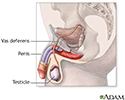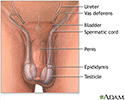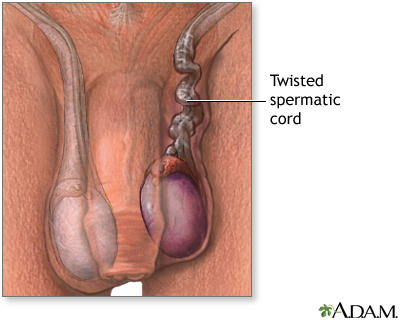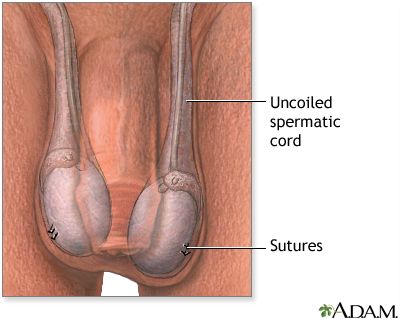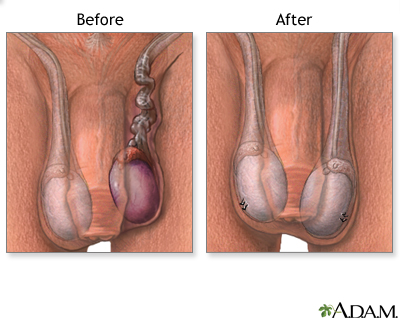Testicular torsion
Torsion of the testis; Testicular ischemia; Testicular twisting
Testicular torsion is the twisting of the spermatic cord, which supports the testes in the scrotum. When this occurs, blood supply is cut off to the testicles and nearby tissue in the scrotum .
Scrotum
The scrotum is a part of a male's body that is located behind the penis. The scrotum is the sac (pouch) that contains the testes, epididymis, and th...

Causes
Some men are more prone to this condition because of defects in the connective tissue within the scrotum. The problem may also occur after an injury to the scrotum that results in a lot of swelling, or following heavy exercise. In some cases, there is no clear cause.
The condition is more common during the first year of life and at the beginning of adolescence (puberty). However, it may happen in older men.
Symptoms
Symptoms include:
- Sudden severe pain in one testicle. The pain may occur without a clear reason.
-
Swelling within one side of the scrotum (
scrotal swelling
).
Scrotal swelling
Scrotal swelling is abnormal enlargement of the scrotum. This is the name for the sac surrounding the testicles.
 ImageRead Article Now Book Mark Article
ImageRead Article Now Book Mark Article - Nausea or vomiting.
-
Lightheadedness
.
Lightheadedness
Fainting is a brief loss of consciousness due to a drop in blood flow to the brain. The episode most often lasts less than a couple of minutes and y...
Read Article Now Book Mark Article
Additional symptoms that may be associated with this disease:
-
Testicle lump
Testicle lump
A testicle lump is swelling or a growth (mass) in one or both testicles.
 ImageRead Article Now Book Mark Article
ImageRead Article Now Book Mark Article -
Blood in the semen
Blood in the semen
Blood in the semen is called hematospermia. It may be in amounts too small to be seen except with a microscope, or it may be visible in the ejaculat...
 ImageRead Article Now Book Mark Article
ImageRead Article Now Book Mark Article - Testicle pulled to a higher position in scrotum than normal (high riding)
Exams and Tests
The health care provider will examine you. The exam may show:
- You have extreme tenderness and swelling in the testicle area.
- The testicle on the affected side is higher.
You may have a Doppler ultrasound of the testicle to check the blood flow. There will be no blood flowing through the area if you have complete torsion. Blood flow may be reduced if the cord is partly twisted.
Treatment
Most of the time, surgery is needed to correct the problem. Surgery should be done as soon as possible after symptoms begin. If it is performed within 6 hours, most testicles can be saved.
During surgery, the testicle on the other side is often secured into place as well. This is because the unaffected testicle is at risk of testicular torsion in the future.
Outlook (Prognosis)
The testicle may continue to function properly if the condition is found early and treated right away. The chances that the testicle will need to be removed increase if blood flow is reduced for more than 6 hours. However, the testicle may lose its ability to function if torsion has lasted fewer than 6 hours.
Possible Complications
The testicle may shrink if blood supply is cut off for an extended time. It may need to be surgically removed. Shrinkage of the testicle may occur days to months after the torsion has been corrected. Severe infection of the testicle and scrotum is also possible if the blood flow is restricted for an extended period.
When to Contact a Medical Professional
Get emergency medical attention if you have symptoms of testicular torsion.
Prevention
Take steps to avoid injury to the scrotum. Many cases cannot be prevented.
References
Ban KM, Easter JS. Selected urologic problems In: Marx JA, Hockberger RS, Walls RM, et al, eds. Rosen's Emergency Medicine: Concepts and Clinical Practice . 8th ed. Philadelphia, PA: Elsevier Mosby; 2014:chap 99.
Barthold JS. Abnormalities of the testes and scrotum and their surgical management. In: Wein AJ, ed. Campbell-Walsh Urology . 10th ed. Philadelphia, PA: Elsevier Saunders; 2012:chap 132.
Elder JS. Disorders and anomalies of the scrotal contents. In: Kliegman RM, Stanton BF, St Geme JW III, Schor NF, eds. Nelson Textbook of Pediatrics . 20th ed. Philadelphia, PA: Elsevier; 2016:chap 545.
Wampler SM, Llanes M. Common scrotal and testicular problems. Prim Care . 2010;37:613-626. PMID: 20705202 www.ncbi.nlm.nih.gov/pubmed/20705202 .
-
Male reproductive anatomy - illustration
The male reproductive structures include the penis, the scrotum, the seminal vesicles and the prostate.
Male reproductive anatomy
illustration
-
Male reproductive system - illustration
The male reproductive system, viewed from a sagittal section.
Male reproductive system
illustration
-
Testicular torsion repair - series
Presentation
-
Male reproductive anatomy - illustration
The male reproductive structures include the penis, the scrotum, the seminal vesicles and the prostate.
Male reproductive anatomy
illustration
-
Male reproductive system - illustration
The male reproductive system, viewed from a sagittal section.
Male reproductive system
illustration
-
Testicular torsion repair - series
Presentation
Review Date: 8/31/2015
Reviewed By: Jennifer Sobol, DO, urologist at the Michigan Institute of Urology, West Bloomfield, MI. Review provided by VeriMed Healthcare Network. Also reviewed by David Zieve, MD, MHA, Isla Ogilvie, PhD, and the A.D.A.M. Editorial team.


